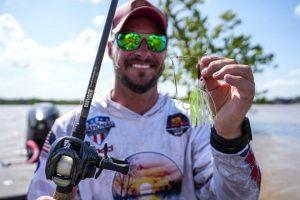Story by Ken Duke
He is the “father of bass fishing” and arguably the most important person in the history of our sport. I could even argue that Dr. James Alexander Henshall is the Shakespeare, the Edison and the Einstein of bass fishing, all rolled into one. He was a man far ahead of his time but perfect for the moment, a beacon for bass fishing’s future. Unfortunately, his contributions and reputation are mostly unknown or underappreciated today.
He is the perfect candidate to launch our “Bassography” series.
Let us begin with the most famous thing ever said about the black bass: “I consider him, inch for inch and pound for pound, the gamest fish that swims.”
That is the seminal statement about the black bass and the most quoted line in all of bass fishing literature. Henshall wrote it about the black bass family in his groundbreaking work on the subject, Book of the Black Bass, published in 1881. His was the first book on the subject and its equal has not been seen since.
Book of the Black Bass is everything about the black bass just as Herman Melville’s Moby Dick is all you want to know about whales. It would be decades before anyone had anything substantial to add to Henshall’s primer.
Born on February 29, 1836 in Baltimore, Maryland, Henshall was a Pisces born in a leap year. His parents, Rev. James Gershom Henshall and Clarissa Holt Henshall, were both born in England. He had four sisters and noted in his autobiography that “as I have no children it follows that I am the last of our branch of the family to bear the name.”
He grew up loving water — “from the babbling brook, or the unruffled surface of a moonlit lake to the wild, tempestuous seas of a Florida hurricane.” Henshall’s first fishing experiences were on a small brook in suburban Baltimore when he was seven years old. Sunfish and chubs were his first quarry, and he caught them fly fishing, casting artificial flies at the end of a “willow wand.” While still a teen, he began making his own fishing rods.
When he was 16, he completed high school, and his family moved to Cincinnati, Ohio. Rather than begin college right away, Henshall took some time away from his formal education and went to work. He took a job as a proofreader in a publishing house, thoroughly enjoying the experience and forging a bond with writing and publishing that would last the rest of his life.
After two years in the publishing business, Henshall returned to Baltimore and accepted a position in the counting house of a large mercantile firm. He found the company there interesting, but the work dull. It was time to choose a career.
He decided to study medicine and returned to Cincinnati in 1855. Ironically, it was on his train ride from Baltimore to Cincinnati that he discovered the fish that would make his name immortal among anglers.
“After leaving Cumberland, Maryland, some gentlemen seated near me were conversing about fishing, and naturally I became an interested listener. Their conversation was mostly about a fish they called black bass, and they were very enthusiastic regarding its gameness and its desirability as a food fish. I had never seen nor read of the fish, nor even heard of it before. The gentlemen were soon joined by the conductor of the train who also proved to be a great admirer of the fish in question.”
On Independence Day of the same year, Henshall enlisted the help of a fishing friend and decided to target black bass for the first time. His friend confirmed the lofty reviews that Henshall had heard. They boarded a train for Morrow, Ohio, and the Little Miami River, armed with a seine and small minnow bucket.
Once they had enough bait, Henshall’s friend hooked a minnow beneath the dorsal fin and tossed it — suspended under a float — into a deep eddy. Nothing happened on the first cast, but on the second….
“The bait had scarcely time to sink ere it was seized and the float disappeared from view and the line went racing through the water, cutting erratic angles and curves in a way I had never seen before, while the rod bent and swayed with the strait when — Ye Gods and little fishes — out leaped a wriggling form of a greenish bronze with wide open mouth, red and cavernous, that seemed to hurl a defiant challenge as with a graceful curve it appeared beneath the surface.”
Without even holding the rod, Henshall understood that the black bass was special.
“So far I had only an impersonal conception of the finesse and strategy of a fish that seemed to possess unlimited power, resistance, fortitude and endurance. I was yet to experience a personal encounter in which my skill, with the help of rod and reel, would be tested and exerted against his innate and indomitable bravery, courage and adroitness.”
Those are lofty accolades for a smallmouth that Henshall described as weighing between 1 and 1 1/2 pounds. Later the same day he would have his own chance to do battle with a black bass.
He was a fan of light tackle and believed very strongly that a rod should be designed for the purpose of fighting a fish rather than merely casting a lure. Around the turn of the 20th century, at an aquatic sports exhibit in Tampa, Florida he challenged a local swimming professor to a contest. Tying a light line to a collar around the professor’s neck and giving the professor a 100-foot lead, Henshall “brought him to gaff in ten minutes.” At the end of the battle, the professor was so exhausted he had to be helped from the pool.
Just the evening before, during rehearsal, Henshall had landed the professor in 7 1/2 minutes. But on the night of the exhibition, he didn’t want to rush things, “in order to give the audience more time to enjoy the novel spectacle.” Henshall reported that with the same rod and line it had sometimes taken him 10 to 12 minutes to land a 2-pound bass.
In May of 1859, Henshall received his medical degree and opened an office in Cincinnati. These were troubled times. Abraham Lincoln had received the Republican Party’s nomination for the office of president and the Union was dividing. Though Henshall’s “sympathies were with the South,” he did not agree that leaving the Union was the best course and so offered his services to the medical corps of the Union army.
He spent much of the Civil War in Kentucky and there learned a great deal about the reels and other tackle popular in the area. When the war ended, he returned to Cincinnati and reopened his old office, but by the end of the year (1865) he relocated to New York City to join a friend’s surgical practice. It was there that Henshall became serious about the scientific study of fish. He found it a pleasant diversion from his work as a surgeon and the bustle of the city. In 1867 he moved to Milwaukee, where he enjoyed bass and other fishing in numerous lakes and streams, eventually building a home on the shores of Pewaukee Lake, near Oconomowoc, Wisconsin. There he served on the town council and was elected to serve as the city’s first mayor.
He also found time to experiment with bass in two ponds on his property. His efforts to raise black bass in a domesticated setting are the first ever recorded. His observations would be the cornerstone of his later writings. While living in Oconomowoc, Henshall began Book of the Black Bass.
“It was written in order to give the black bass its proper place among game-fishes, and to create among anglers, and the public generally, an interest in a fish that had not been appreciated as its merits deserved.”
Shortly after Forest and Stream (later Field & Stream) magazine was founded in 1873, Henshall became a contributor under the pen name Oconomowoc. His articles championed the black bass as a premier sport fish and recommended certain tackle for anglers pursuing bass. In particular, he advocated an 8-foot rod that most of his contemporaries considered too light for bass fishing. Henshall never patented the design but created demand for the “Henshall rod” through his articles in Forest and Stream. A Vermont rod-maker, Charles F. Orvis, began making the rod to Henshall’s specifications and wrote to the doctor that he couldn’t keep up with demand. The Henshall rod was the standard in the bass market for more than 20 years, until better materials and craftsmanship came along and allowed lighter and sometimes shorter designs.
Before overseeing the completion of his book by a Cincinnati publisher, Henshall and several of his patients decided to spend several months in Florida, enjoying the fishing, camping and fine weather. While there, he reported catching a 20-pound largemouth from a bay off the San Sebastian River using a sunfish as bait. At the confluence of the North and South Halpatiokee rivers, he caught a 14-pound largemouth on a fly rod.
Legend has it that Henshall combined fishing with house calls during his years as a practicing physician. He carried a buggy whip that doubled as a fishing rod or hid a jointed fly rod in an umbrella. He was also known to keep a few flies in his pockets or in a prescription book. His pill bag concealed a reel.
Henshall’s notoriety among today’s anglers stems almost exclusively from the publication of his two books dedicated to the black bass and bass fishing, Book of the Black Bass (1881) and More About the Black Bass (1889). Though most famous for his “gamest fish that swims” comment, his prescience regarding the bass and its place in the world of sportfishing is perhaps more remarkable.
“That he will eventually become the leading game fish of America is my oft-expressed opinion and firm belief. This result, I think, is inevitable; if for no other reasons, from a force of circumstances occasioned by climactic conditions and the operation of immutable natural laws, such as the gradual drying up, and dwindling away, of the small Trout streams, and the consequent decrease of Brook Trout, both in quality and quantity; and by the introduction of predatory fish in waters where the Trout still exists.”
In 1897 Henshall went to work for the U.S. Fish Commission as Superintendent of the Bozeman, Montana fish hatchery. There he focused his attention on grayling for 12 years before being transferred to the Tupelo, Mississippi hatchery in 1909. In 1917, at the age of 81, he retired from the Fish Commission due to failing eyesight.
Two years later, Forest & Stream agreed to publish Henshall’s autobiography in 27 installments running from May 1919 through July 1921. By this time, the doctor was blind and in dire need of money. He used the meager earnings from the magazine and proceeds from the sale of his precious fishing gear to help support himself in his final years.
Henshall died on April 4, 1925, in Cincinnati, at the age of 89.




